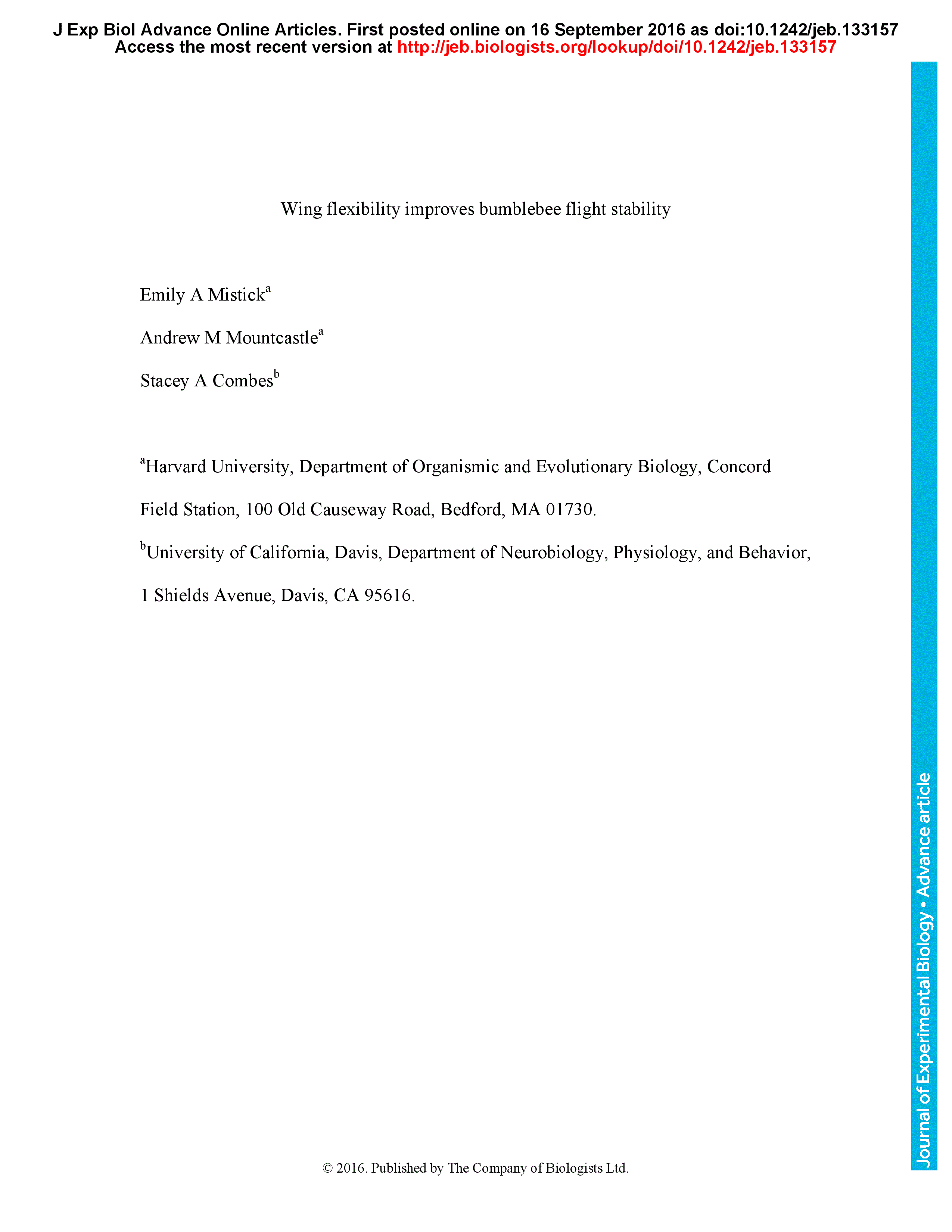Insect wings do not contain intrinsic musculature to change shape, but rather bend and twist passively during flight. Some insect wings feature flexible joints along their veins that contain patches of resilin, a rubber-like protein. Bumblebee wings exhibit a central resilin joint (1m-cu) that has previously been shown to improve vertical force production during hovering flight. In this study, we artificially stiffened bumblebee (Bombus impatiens) wings in vivo by applying a micro-splint to the 1m-cu joint, and measured the consequences for body stability during forward flight in both laminar and turbulent airflow. In laminar flow, bees with stiffened wings exhibited significantly higher mean rotation rates and standard deviation of orientation about the roll axis. Decreasing the wing’s flexibility significantly increased its projected surface area relative to the oncoming airflow, likely increasing the drag force it experienced during particular phases of the wingstroke. We hypothesize that higher drag forces on stiffened wings decrease body stability when the left and right wings encounter different flow conditions. Wing splinting also led to a small increase in body rotation rates in turbulent airflow, but this change was not statistically significant, possibly because bees with stiffened wings changed their flight behavior in turbulent flow. Overall, we find that wing flexibility improves flight stability in bumblebees, adding to the growing appreciation that wing flexibility is not merely an inevitable liability in flapping flight, but can enhance flight performance.
Wing flexibility improves bumblebee flight stability
Currently Viewing Accepted Manuscript - Newer Version Available
- Split-screen
- Views Icon Views
- Open the PDF for in another window
-
Article Versions Icon
Versions
- Version of Record 01 November 2016
- Accepted Manuscript 01 January 2016
- Share Icon Share
-
Tools Icon
Tools
- Search Site
Emily A. Mistick, Andrew M. Mountcastle, Stacey A. Combes; Wing flexibility improves bumblebee flight stability. J Exp Biol 2016; jeb.133157. doi: https://doi.org/10.1242/jeb.133157
Download citation file:
Advertisement
2023 JEB Outstanding Paper Prize shortlist and winner

The JEB Editors are delighted to announce the shortlisted authors for the 2023 JEB Outstanding Paper Prize. Read the winning paper - Tiny spies: mosquito antennae are sensitive sensors for eavesdropping on frog calls - by Hoover Pantoja-Sanchez and Brian Leavell from Ximena Bernal's lab at Purdue University, USA.
JEB Science Communication Workshop for ECRs

If you’re an early-career researcher interested in science communication and are attending the SEB Annual Conference in Prague this summer, come a day early and join the JEB Editors at a sci comm workshop to learn the key writing skills needed to promote your research to a broad audience beyond your peers (1 July at 14.30-17.30). Places are limited to 24 attendees, and applicants should apply through the SEB registration page by 30 April 2024.
Bridging the gap between controlled conditions and natural habitats in understanding behaviour

Novel technologies enable behavioural experiments with non-model species, in naturalistic habitats and with underexplored behaviours. In their Commentary, Scholz and colleagues discuss how to obtain a deeper understanding of the natural ecology and lifestyle of study animals.
Beluga metabolic measures could help save species

To help save animals from extinction, it’s important to understand what each species needs to survive. This led Jason John et al. to measure the metabolic rates of captive belugas to develop a ‘fish calculator’ showing that the whales need to eat ~23 salmon per day.
ECR Workshop on Positive Peer Review

Are you an ECR looking for tips on how to write concise, astute and useful manuscript reviews? If so, join the JEB Editors at a 2-hour JEB-sponsored Workshop on Positive Peer Review at the Canadian Society of Zoologists annual meeting in Moncton on 9 May 2024 at 13.00-15.00. There are 25 spaces for ECRs and selection is first come, first serve. To sign up, check the ECR Workshop box when you register for the CSZ meeting.



